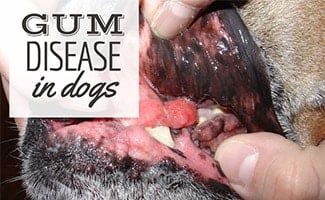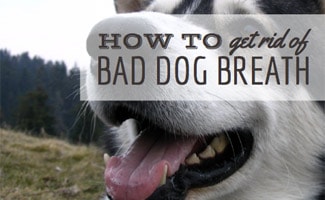Does My Dog Have Gum Disease? – CanineJournal.com

This disease can be silently destructive, eating away the supporting structures around the teeth without apparent signs and symptoms until it’s gone past the point for reversing its effects. If it goes too far, perfectly healthy teeth can be lost because nothing will hold them in place. Do you know how to protect your dog from gum disease?
What Is Gum Disease?
Gum disease is a bacterial infection in the gums, ligaments, and bone surrounding the teeth and is the most common dental concern for dogs. This disease is also the most common reason dogs lose teeth. Gum disease isn’t the same as a tooth infection. While gum disease affects the teeth’s supporting structures, the gums, ligaments, and bone, a tooth infection only affects the tooth itself.
Four Stages Of Gum Disease
Gum disease in dogs happens in four stages.
1. Gingivitis
Stage one, known as gingivitis, occurs when plaque and tartar cause inflammation leading to red bleeding gums. This stage is the only one that’s entirely reversible because there’s no bone loss. If treatment doesn’t occur during gingivitis, the disease progresses to stage two.
2. Early Periodontitis
Early periodontitis, or stage two, is when bone loss begins. Inflammation, plaque, and tartar start to move underneath the gums and affect the bone. Bone loss in this stage can reach 25%. Your dog can’t grow bone back once it’s gone, but treatment can prevent it from progressing.
3. Moderate Periodontitis
Once a dog reaches stage three, or moderate periodontitis, bone loss reaches 25% to 50%. This stage tends to be a bit more uncomfortable as gum inflammation and bleeding is more noticeable, and teeth can become loose.
4. Advanced Periodontitis
In this final stage of periodontal disease, known as stage four or advanced periodontal disease, gum disease becomes a chronic infection, and bone loss is over 50%. There’s a good chance your pup will be in pain during this stage, and teeth may fall out. Another risk is bacteria entering the bloodstream, spreading to internal organs and throughout the body.
Can My Dog Die From Gum Disease?
While gum disease itself is not fatal, if you don’t treat it, it can lead to other issues that can be deadly, like problems with the kidneys, liver, and heart.
Signs And Symptoms

- Bad breath
- Brown or yellow teeth
- Loose teeth
- Pain when eating
- Plaque and tartar buildup
- Red and bleeding gums
- Swollen gums
- Tooth loss
- Trouble eating
What Does Gum Disease Look Like?
Here are some examples of what you might see in a dog with gum disease’s mouth.
Causes
Bacteria is to blame when it comes to gum disease. All dogs have bacteria in their mouth, and when they eat, bacteria begin to produce plaque, a sticky film that begins to coat the teeth. The body sees that plaque as a foreign object and reacts to that with inflammation in the gums.
If you don’t remove the plaque with brushing and regular dental cleanings over time, it will become hard, turning into tartar. As this progresses, gum tissue and bone start to break down, and perfectly healthy teeth have no support system to hold them in place, so teeth are lost.
Treatment
Treatment depends on the stage of gum disease in your dog’s mouth, and anesthesia may be necessary. While the dog is under anesthesia, the vet may also take dental x-rays and perform a complete oral exam to look for any additional dental concerns.
- Stage one: A regular dental cleaning can treat gingivitis and reverse the effects on the gums.
- Stage two and three: With early to moderate periodontitis, a deep cleaning, known as scaling, can remove plaque and tartar to halt the disease’s progression.
- Stage four: Since bone loss can be significant in advanced periodontitis, deep cleaning and extractions may be necessary to stabilize the gum disease.
At-Home Treatment
Treating gum disease at home can be challenging, depending on the stage of the disease. Things like dog mouthwash and tartar control toothpaste may help gingivitis but can’t treat a mouth with advanced periodontal disease. It’s always best to consult with your vet if you think your dog has a dental concern.
Natural Remedies
If you’re looking for a natural way to treat your dog’s gum disease, you might consider a few natural products like TrueBlue dental wipes, and Merrick Fresh Kisses for extra small, small, medium, or large dogs which are all-natural options to help reduce plaque and tartar buildup. However, the only way to stop gum disease from progressing is to see your vet so they can evaluate and treat your dog for his specific needs.
There are a few essential oils that may be helpful, but it can be tricky to know which ones to use and how to use them safely. Again, your vet’s guidance is your best bet.
How Much Will It Cost To Treat My Dog’s Gum Disease?
The cost of treating gum disease can vary, but you’ll need to consider that even most routine dental care requires your dog to have general anesthesia, so it may cost more than you think. Your vet may also want to do blood work before the anesthesia to ensure your dog is healthy enough to be put under.
Costs may range anywhere from $500 to $1,000 for a cleaning or a deep cleaning with anesthesia. If extractions also have to be done, that cost can increase to several thousands of dollars.
Gum disease treatment can be costly. Before your dog has any problems, you might want to look into the best pet dental insurance. These plans, which are part of pet insurance, may help cover the cost of preventing and treating gum disease. Pet wellness plans may be another option to consider to help cover preventative dental cleanings.
Prevention
At-Home Teeth Brushing And Dental Chews
Even though gum disease is common in dogs, you can still do a lot to prevent it from getting to the advanced stages. Brushing your dog’s teeth is essential to reduce the number of bacteria in your dog’s mouth and keep it clean.
You can also give your pup dental chews, rawhides, and safer rawhide alternative treats to help maintain their teeth and control tartar build-up.
Dental Cleanings & Annual Vet Exams
Regular dental cleanings under general anesthesia are another way to prevent gum disease. These cleanings are the most effective way to remove plaque and bacteria from your dog’s mouth before he gets gum disease.
Finally, taking your furry friend for his annual check-up at your vet gives him a chance to have a thorough dental checkup too. These exams are when your vet may find signs of gum disease and recommend treatment to stop it.
A Vet’s Perspective On Gum Disease
In this three-minute video from Heron Lakes Animal Hospital, Dr. Lera talks about Armani, a nine-year-old Pomeranian, his gum disease, and his treatment.
Learn More About Your Dog’s Mouth
One of the best ways to help your dog have a healthy mouth is to learn more about your dog’s dental health. Check out our article about how many teeth dogs have, written by our experts, to understand what you’re looking at when checking things out in your pup’s mouth.
Is your dog showing signs of gum disease?





